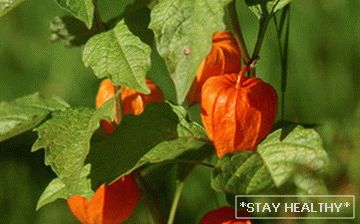 Tue, Mar 15, 2016
Tue, Mar 15, 2016
The genus Physalisov of the family Solanaceae (Solanoideae) includes
more than 100 species of herbaceous plants, places of growth
which are tropical and subtropical areas, the main
manner – Central America and southeast North America.
We have the most common decorative
физалис обыкновенный (Physalis alkekengi) или
physalis franche (Physalis francheti), which is also called Chinese
flashlight. It is named after its first explorer, Andre Rene.
Franchet, who was a famous French botanist. This Physalis
comes from faraway Japan and is grown as
decorative culture since 1894.
A distinctive feature of decorative Physalis is bright.
orange-red shell, resembling a paper Chinese lantern,
which envelops its fruit and reaches 6 cm in diameter. It is she who
makes the plant valuable from a decorative point of view. At the beginning of summer
Physalis begins to bloom white, small and completely inconspicuous
flowers, from which to the beginning of autumn the fruit ripens, posing in
all its glory.
Ornamental Physalis has various cultivars, to which
include plants with different heights and sizes of orange cups.
Tall Physalis Franche can reach 90 cm and height
miniature physalis-patio does not exceed 30-45 cm. Physalis is very
widely used for decorative purposes, and in many countries it
even an attribute of Christmas and New Year. Besides his
You can easily grow in our conditions.
Contents
Physalis – growing and care
Physalis Franche is a very unpretentious plant. So, he is
the most frost-resistant type of Physalis, and is able to withstand
temperature up to -30ºC. Physalis tolerates equally well and
partial shade and sun, therefore it is allowed to place it under the trees
or shrubs. And yet, his cups will be bright and large.
only in sunny places.
The soil for Physalis must be prepared in advance by
putting humus, compost, manure (but not fresh) into it, or
peat, as well as ash. Organic fertilizers can be replaced.
complex mineral. Sour soil need
to chaff.
This crop places high demands on soil moisture,
However, areas with stagnant water are not suitable for it. Physalis
needs standard weeding care,
loosening, weekly watering (in dry weather it is necessary
water through the day). Regular watering should be done before
August, then they need to stop to accelerate ripening
fruits.
Watering combine fertilizing complex fertilizer in the liquid
the form. The first feeding is carried out during the flowering of plants, the second
– during the formation of the fruit, and the third time physalis
feed up 2-3 weeks after the second feeding. With this
The purpose of using mineral fertilizers. At 10 liters of water you need to take from
10 to 15 gr. potassium salt, from 10 to 20 gr. superphosphate and 10 gr.
ammonium nitrate. Consumption of such fertilizer is 10 liters per 1 square.
m. You can use for feeding bird droppings, which
should be diluted in water at a ratio of 1:20 or slurry (1:10).
For one plant, 0.5 liters of this fertilizer is used. Need to
remember that excess nitrogen fertilizer is bad for the crop.
When growing Physalis, it is important to take into account crop rotation:
so, it can not be planted after solanaceous crops, but it will
to grow very well in the area where cucumbers grew up to it,
cabbage, pulses or root vegetables.
No need to form plants, only for tall varieties
Physalis is advisable to bind, to save
slenderness of the branches used in winter bouquets. To
decorative lanterns had time to ripen to cold in the end
August need to pinch the tops of Physalis.
Physalis – пересадка и breeding
To prevent the degeneration of plants, their rhizomes are 6-7 times
years are subject to division and transplantation. Planted stunted physalis
necessary according to the scheme 40×50 cm, medium lengths – 40×70 cm, tall
– 60×80 cm
They also multiply well by growing seedlings. With
this method should not sow the spring physalis seeds in the spring
moistened compacted substrate, cover the seed container
glass and keep it in a warm place. After the seeds
germinate, you need to remove the glass and then grow the seedlings in the light when
moderate watering to prevent black disease
leg.
The best mode for growing seedlings is the temperature
air from 20 to 22 degrees. Every 2 weeks should be fed
seedlings liquid soluble fertilizer for seedlings. After education
3 of these leaves need to be seated one by one in peat
pots or plastic cups, deepening to the first leaflets.
Tall and medium grades of Physalis before planting in the ground need
transplant again in larger pots.
After the threat of frost has passed, the seedlings in phase 6-8
these leaves should be planted in open ground,
pre-hardened, periodically exposing to the street.
The time from germination to maturity of lanterns is
90-150 days.
Physalis – болезни и вредители
With правильном выращивании все физалисы не поражаются болезнями
and pests. However, excessive moisture may occur.
stem rot, which is fought primarily agrotechnical
methods: observance of crop rotation, destruction of post-harvest
residues, etc., as well as by spraying plants with drugs
copper.
Physalis can be damaged by pests. To от нее
To get rid of, it is necessary to spray the plant with insecticides.





